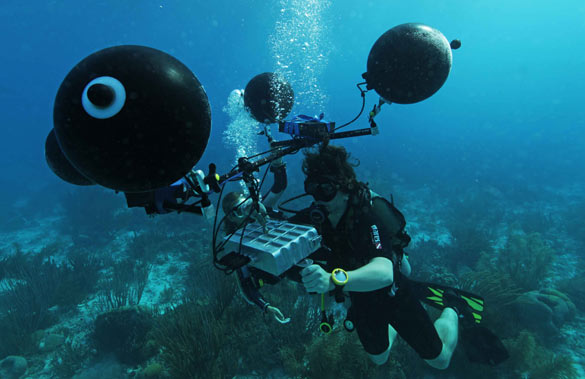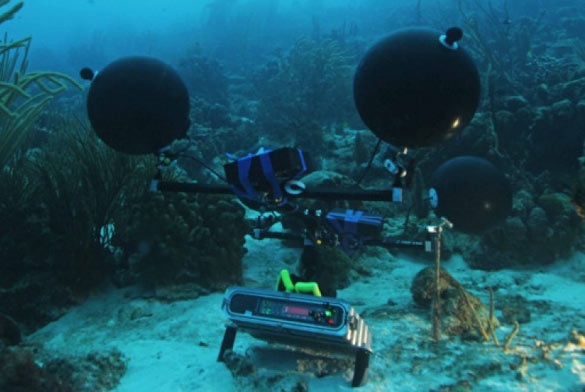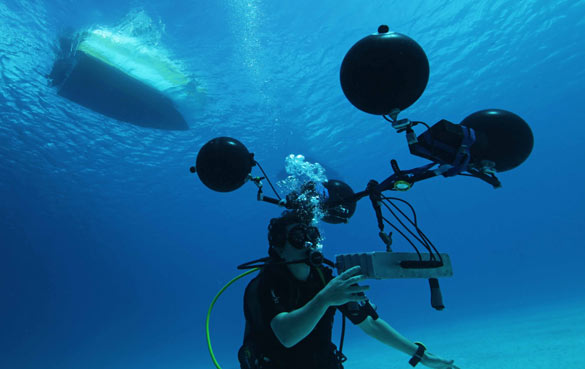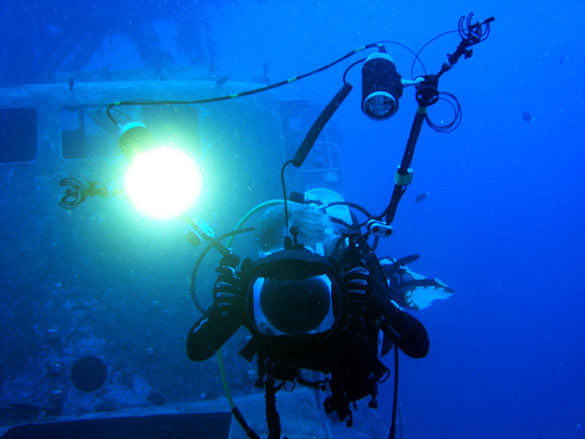The cannon crackers of the pistol shrimp
Author: Timo Klinge
Photos: Ambient Recording

A new dimension of underwater documentary. During the 14-day production of the documentary at Bonaire, spatial underwater surround-sound recordings have been used for commercial purposes for the first time. Humans, not being able to hear clearly or spatial under water or in space, can experience a real audio-visual journey into the coral reef for the first time and renew their understanding of the aquatic habitat. The necessary technology has been developed specifically for this purpose and is now also available for other productions. A team of editors, tourism industry and commerce have supported and funded this unprecedented project.
The background story
In 2008, UNESCO launched an expedition to the barrier reef off Belize. The purpose of this trip was to create an audio-visual record of the actual status of the last intact coral reef systems in the world.
The technical challenge was immense: Five HD cameras on a rig should create all-dome recordings. But they wanted to break new ground with the recording of sound, too. Instead of using mono recordings of inferior quality - the industry standard at the time - the world's first underwater surround recordings should be made. The development of the necessary recording systems alone took two years.
The recordings of this expedition brought unexpected results. They revealed not a very silent, but a very loud and vivid underwater world with a variety of sounds previously known only from the jungle. Back in Hamburg during the post-production, however, they realized that due to an unfortunate series of technical problems and errors, most of the imagery was unusable - an absolute disaster for the team, of course.
Nevertheless, the sound recordings were so convincing that they applied for an international patent for the new technique. With the help of an EU-EXIST funding, a new company (Sonar Surround) was set up to develop the prototype into a marketable product. In the summer of 2010, the leading film sound company Ambient Recording GmbH took over the new startup Sonar Surround to become the first supplier for professional underwater sound recordings worldwide.
The idea
A part of the team from the first expedition didn't want to accept the failure. The public should learn about this amazing variety of sounds which brings this habitat a lot closer to us. In the Caribbean, one animal is primarily responsible for a permanent background noise: The "Pistol Shrimp". This species, only a few centimeters in size, is one of the loudest animals on earth. By closing his enlarged claw so fast that water evaporates and when this bubble implodes due to pressure, this little guy produces up to 140 decibels (louder than a cannon cracker) and a temperature similar to that of the sun. With this weapon it kills or stuns intruders and prey. When night falls, this shrimp will hunt in packs and the whole reef then crackles and pops.
Hence it was the intention for a second expedition to the Caribbean to capture this unique natural spectacle of sound and vision. The tour operator Karibiksport and Ambient Recording decided to make another attempt to create the first true underwater surround documentary in co-operation. Equipped with less time and money, but with more experience, they went to Bonaire. The plan was to make a short documentary about five to ten minutes in length, which could be viewed online for free - supported and accompanied by a photo-report by Europe's largest scuba diving magazine "tauchen"

The diversity of flora and fauna under water almost managed to make the team speechless on a daily basis. We had never seen such a high concentration of fish before. At almost every dive we saw e.g. surprisingly tame turtles. Even with the naked ear one could hear parrotfish scrapping on the coral. The crackle of pistol shrimp was omnipresent, while croakers and sea robins were singing constantly. The variety of noise was particularly impressive at night.
Just ten days of shooting were very ambitious for this project . Accordingly, the shooting schedule was tight. Three to four dives were completed per day, often at night, too. During the breaks on the surface the shots on land were made. As our cameraman and guide was from the area, we were able to retake shots, that were initially impossible due to weather conditions, after our departure.
Our procedure was as follows: First, we took a sailing boat or speed boat to supposedly good diving spots. There we used our sensitive hydrophone (TC4042 in a DS directivity sphere) to listen and check if we had found an acoustically interesting spot - and especially if there were pistol shrimps around.
If we had found what we've been looking for, we were diving to this spot either directly from the boat or from land later. Since we were up to five divers in the water with open systems, the resulting noise made high-quality audio recordings almost impossible, of course. Therefore, we decided to fix the surround rig.

In the meantime we made other video recordings in the area with the other cameras. The cameras were equipped with a TC4013 hydrophone. This way, we could use the pictures of the other cameras, if nothing exciting was happening in front of the rigs and add some atmosphere recordings taken there. This technique proved particularly useful during the day, because our lights on the rig were no big attraction then.

One of our biggest concerns was handling the big rig underwater. However, it turned out that the calculations were correct and the 25-pound rig with two buoyancy devices was tared perfectly neutral. Thus even a relatively inexperienced diver was able to handle this colossus without problems.
As always, the real problems showed up in unexpected places. Unfortunately it was quite difficult to actually locate the pistol shrimp (because its sound was omnipresent). The shrimps were literally everywhere and nowhere. We sought advice from our guide, from park rangers, fishermen and many others. But it took a lot of patience until we finally found the shrimp, and even more patience until we saw him in action.

But each night, when we looked at the material while sipping at Carribean rum and were talking about the day of shooting, we remembered the unbelievably beautiful things that we could see every day. The final result remains to be seen, but at least after discovering our pistol shrimp, we are all confident that the work has paid off.
Das Team
Evert Bleijenberg and Ingo Vollmer two very experienced underwater cameramen were enlisted for this production. Because Evert Bleijenberg lives on Bonaire and and is underwater at an almost daily basis, he was also an excellent guide. Inka Lübcke and Michiel van Heusden (Bonaire) took the jobs as Line Producers and were assisted by Lisa Weinreich. Timo Klinge (the developer of the underwater recording technology) was the sound engineer and editor Michael Kruger accompanied us for reporting in the journal „tauchen".
Material
Especially for this expedition, the first underwater housing for professional sound recorders was developed. (7 Series by Sound Devices) It is made of hard anodized and PTFE-coated aluminium, provides access to all major functions and to eight waterproof audio inputs. Thanks to the slightly negative buoyancy, even divers with little experience can use it easily. It can withstand the pressure in depths of more than 100 meters and can be controlled easily by two handles. A surround frame can be mounted to this housing, which in turn can carry up to six DS30 directivity spheres.

Five TC4042 hydrophones (the DS spheres) have been used, three TC4013S with the camera housings and one TC4032 to record distant signals. Recordings were made with a Sound Device 788T in 24-bit 48kHz
 How to resolve AdBlock issue?
How to resolve AdBlock issue?